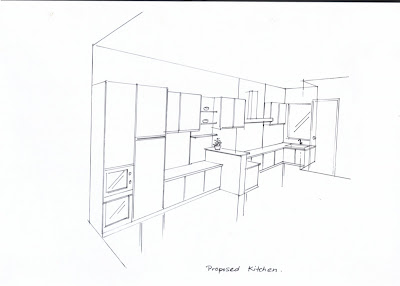You see, kitchen showrooms are able to produce 3D designs fast because they just present a modular cabinetry design without considering the surrounding tile colours, the wall colours, the usage of surrounding areas, etc. A few years ago, when we were just doing kitchen cabinets, that was what we did. MERELY design the cabinets, without considering the surrounding areas.
I later empathise with the house-owners who, despite spending lots of money on house renovations, just didn't know how to get it right for the rest of the areas - the plaster ceiling was wrong, the electrical points were wrong, the furnitures were of wrong colours, the wall colours and tiles were all not matching, etc.
That's why now I go on site visits ( which I did not do a few years ago ), to meet clients to understand their likings so that I can incorporate the information that I gather into my designs. That way, I will understand which direction the sunlight comes in, whether to propose thick curtains or just sheers, whether my proposed designs will match the exterior of the house, whether the exterior colours will match the interiors etc.
I would like to share the various stages of my work from quotations to 3D designs…
We are currently halfway through renovation work at Damai Perdana. These are the stages of our work.
1) We asked client to give a budget for us to know what to propose.
2) I did some hand-sketches and submitted these along with the price quotation.



3) When customer agrees with the pricing, then we asked for a 10% non-refundable deposit to start the designing work.
4) I submit the 3D drawings with a few colour combinations for them to choose from. When the colours are agreed upon, then only we start the actual renovation work with the collection of another 20% payment.
5) Subsequent payments are on a weekly basis as work progresses.
This job costs :
A. Living Hall
Divider at entrance RM1,750.00
Altar RM980.00
Carpentry work at TV area RM3,660.00
Divider at TV area RM2,950.00


B. Dining
Framed mirror c/w bevel edge at dining area RM1,650.00


C. Kitchen
Wall cabinet RM2,100.00
Base cabinet RM1,200.00
Solid surface RM1,260.00
Tall unit RM1,800.00
Fridge cabinet RM1,200.00
Tear down dividing wall RM1,200.00
Concrete slab c/w 2'x2' tile RM3,150.00
Under slab door frame, door & drawers RM1,795.00
Mosaic tile @ hood area RM1,200.00
Sink 2 bowl with tap RM580.00
Plumbing work
- reposition inlet & outlet & reconnect RM600.00
D. Painting
Exterior wall & interior wall painting job (incl. Nippon paint) RM5,200.00
Skim coat on uneven wall surface only RM800.00
Updating The Client
Because this customer is working overseas, I will take pictures of the house every few days to update him on the progress. Our payments are collected on a progressive manner depending on how much the job has been delivered. I have an idea to write a posting on determining progressive payments and how much to pay to help those renovating the house on a DIY basis so that you reduce the risk of contract workers absconding with the money.

















